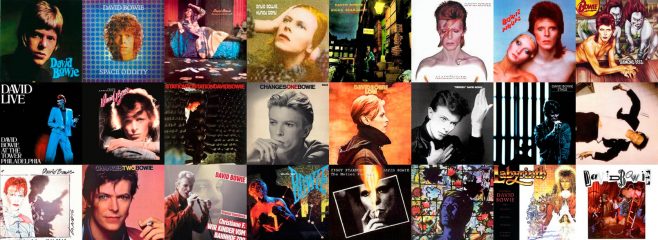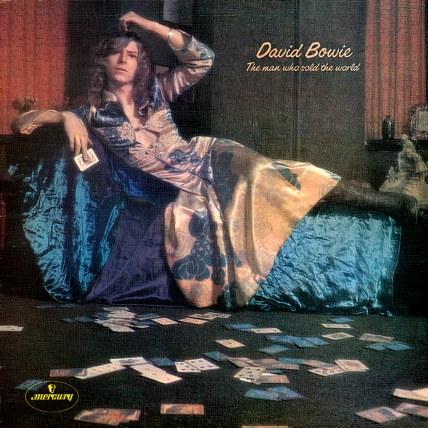
“The Man Who Sold The World” is David Bowie’s 3rd studio album, originally released on 4th November 1970.
By 1970, things were beginning to finally look promising for the 23 year old Bowie. After 5 years of struggle with flop after commercial flop, Bowie finally had the hit he was so desperate to achieve with the “Space Oddity” single the previous year. Although the parent “David Bowie” album had disappointing sales and failed to chart, Bowie had one more album to deliver in his contract with the Mercury label.
Only Tony Visconti in the producer’s chair (and bass guitar) remained from the previous album. The recording sessions which took place predominantly at Trident Studios between April-May 1970 introduced two new session musicians who would prove to be incredibly important in the coming years.
On drums, Bowie recruited the brilliant Mick “Woody” Woodmansey who would become one of the future “Spiders From Mars“. From Hull in Yorkshire, Woody would provide Bowie with a drummer who was both technically excellent and had the energy and drive in really rock it both in the studio and in live performances.
But the big recruit was Woody’s friend from Hull and soon to be fellow “Spider From Mars“, Mick “Ronno” Ronson on guitar who would prove to be Bowie’s right-hand man during the up-coming Ziggy Stardust years. Not only was Ronson a brilliant guitarist and live performer (who Bowie would later describe as his Jeff Beck), but also importantly a wonderful arranger, who would help transform some of Bowie’s songs into something truly magical (think “Life on Mars” as a perfect example). Ronson would turn out to be a perfect foil for Bowie and this album marks the start of their amazing collaboration.
Adding another layer to the overall sound was Ralph Mace on the Moog Synthesizer, the 40 year old head of the classic music department at Mercury Records. His work on tracks such as “All The Madmen” gave them a extra, futuristic dimension that would become a trademark on Bowie’s future work. Ralph would only ever work with Bowie on this album, but just image the stories he could tell his grandchildren…
Having recently got married to Angie Bowie (nee Barnett), Bowie was a little distracted by his new love and to the frustration of those involved in the project, would spend more time smooching on the studio couch than work on recording the album and writing the damn lyrics. That said, what an amazing set of lyrics he came up with in the end.
With dark themes that include the occult, demonic monsters, deranged madmen, possessed children, snipers taking pot shots at civilians, super computers gone wrong and the end of humanity, the accompanying music is just as dark and “heavy”. The album features possibly Bowie hardest rock sound (verging on “heavy metal”) on any album (including the “Tin Machines” albums), with Ronson, Woody and Visconti on bass sounding collectively like a freaked out version of Led Zeppelin, with a sound and vibe just as heavy as anything found on their first 3 albums.
The album opens with the truly epic “The Width Of A Circle“. The song begins with Bowie’s acoustic and Ronson’s electric guitars starting the catchy main riff before the rhythm sections kicks in and kicks in hard. The first half touches on themes of schizophrenia and madness as Bowie meets a second self who in turn considers himself a god-like figure. With further references to “Kahlil Gibran” (famous for his books “The Madmen” and “The Prophet“) and homosexual erotic encounters, Bowie sings with a new found strut and naked, high pitched “Englishness” that would become is vocal style throughout his glam rock years. The quieter, slower tempo middle section features a wonderful Ronson solo before the last section rocks it back up again, this time with disturbing imagery of a sexual encounter with a devil-like figure who takes his body, mind and soul into the pits of hell. It’s one of the most powerful of tracks in the entire Bowie cannon and an early Bowie classic. Performed live throughout his entire glam period, including the “Diamond Dogs” tour, the track would often be substantially extended past it original 8 minute length to give the band the opportunity to rock it out and more importantly, time for Bowie to change costumes.
Two special versions of this track are worth noting. The first is found on the superb “Bowie At The Beeb” album, which features a very early version of the song with the first ever performance by Bowie with Ronson (who Bowie had only just met a few days previously) on The Sunday Show with John Peel. The second is fantastic live version from the equally superb “Live Santa Monica ’72” album. Both are well worth checking out.

We have a couple of seconds to catch our breath before the acoustic guitar intro to the remarkable “All The Madmen” moves from speaker to speaker. Based in large part on his half-brother Terry Burns who was currently housed at the Cane Hill mental hospital and who had been suffering from schizophrenia for quite some time, the song tells of a horrifying alternate reality where the madmen run around freely while it’s the sane who are kept imprisoned. The first verse starts slowly with mainly acoustic guitars before Woody’s cymbals and recorders enters the fray and then it’s all in for the chorus, with Visconti’s bass predominant in the mix. A short Ronson solo preludes the eerie middle section where softly spoken vari-speed vocals denote all is far from well (the laughing gnome this is not). The second half is just a musical triumph, with the pace ramping up still more and while Bowie begs for a lobotomy, Mace’s moog fills up all the remaining atmospheric space for the piece to reach its musical crescendo. The band are simply fabulous as the ending “Zane, zane, zane, Ouvre le chien” chant draws out slowly to silence to finish the piece. This is one my all time favourite tracks, I can’t rave about it enough. A+++, with Visconti deserving much credit for his superb production work. Bowie never performed this live until it was surprisingly included as part of the set for the “Glass Spiders” tour in 1987 where it was one of the highlights. To see it performed live on 8 glorious nights in Sydney remains one of my highlights in life. Bowie returns again to the end refrain in 1993 on “Buddha of Suburbia“.
“Black Country Rock” comes as almost comic relief. A decent enough standard rocker, it’s the weakest track here, although Bowie’s rather impressive impersonation of his friend Marc Bolan never ceases to put a smile on my face. He would later dedicate another song to his chum and musical rival Marc Bolan with “Lady Stardust“.
“After All” is yet another wonderful Bowie gem contained within. A much slower, waltz-timed piece, it’s no less powerful with its nightmarish vision of possessed children. The middle section reminds me of The Beatles with its circus like music but the chilling final lines “Live til your rebirth and do what you will, Forget all I’ve said, please bear me no ill” has little to do with the summer of love but more so Aleister Crowley and the occult. The backing vocals “oh by jingo” does little to lighten the mood and is an early example of Bowie/Visconti’s wonderful use of backup vocals to give tracks an extra dimension. Add this to the ever increasing list of Bowie masterpieces that few folks are likely to have ever heard.
Side two begins with “Running Gun Blues” and the opening lines “I count the corpses on my left, I find I’m not so tidy, So I better get away, better make it today, I’ve cut twenty-three down since Friday” suggests things are only getting grimmer. Telling the tale of a crazed Vietnam veteran, come serial killer who hasn’t lost the taste for killing and starts plugging a few civilians, this is Bowie at his darkest. The music here is classic hard rock but with slight flourishes that gives it that Bowie signature such as the moog piping in the background. Another song that I don’t think Bowie was ever brave enough to perform live. Bowie returns to the topic of a mass killer, with its anti-gun undertones on “Valentine’s Day” from the 2013 album “The Next Day“.
“Saviour Machine” slowly builds up as Bowie introduces us to President Joe, who creates a super computer, the “Saviour Machine” called “The Prayer” that’s able to cure mankind from all its ills and problems such as war and famine. However, once mission is completed, it gets bored with little now to do and decides to then destroy mankind for some amusement. Basically, the Oracle Autonomous Database meets the Terminator. The musicians are again on top form here, with the music having a very strange quality to it, in structure (with just one verse, followed by two bridge/chorus combos), in tempo which is all over the place and with the overall musical atmospherics. Bowie vocals here are excellent, menacing and powerful and a highlight of the track. Yet again, a track that I don’t believe Bowie has ever performed live.
Bowie hasn’t ever performed “She Shook Me Cold” live either, basically the heaviest, hardest rock track of those contain within, giving Ronson the chance to play out his Jeff Beck come Cream guitar fantasies. Detailing a particular sordid sexual encounter, Bowie seems to revel in all the naughtiness. It’s a theme he would return back to with the rather hilarious Ziggy era “Sweet Head“.
“The Man Who Sold the World“, the spell-blinding title track comes next. This along with “Space Oddity” is possibly his best know song from Bowie’s Mercury period, although this wasn’t the case for many years despite it being arguably one of Bowie’s very best songs. With a wonderful guitar riff by Ronson, a divine guiro percussion sound by Woody, Vistonti’s bouncing bass and Bowie’s hauntingly beautiful vocals, it really is a magical track. The outro with its slowly building vocals is just a fabulous sonic treat. As with much of Bowie’s lyrics to come, they’re wonderfully cryptic and evasive here, although the familiar theme of schizophrenia returns, with a good touch of H. P. Lovecraft thrown in. My pick for the best track, but it’s a close call.
Bowie would all but forget this masterpiece until he re-recorded it again for Lulu in 1974 for what became a No. 3 hit in the UK. But it wasn’t until Nirvana (huge Bowie fans) recorded a wonderful version as part of their live MTV Unplugged appearance and subsequent album/single in 1995 that the song became widely known. Obviously thrilled and flattered by all the attention the song received, Bowie started to add the song to his own live sets (albeit in quite an altered form in his 1995 “Outside” tour). Bowie though was just a little miffed at all the “younger” folks who thought it cool he was performing a Nirvana cover…
The album closes with “The Supermen” which further explores the “Lovecraftian” Elder Gods theme from the title track, a mystical race who sadly bemoan and wish for the only thing they can’t have, mortality. Another key influence in the apocalyptic nature of things here is clearly Nietzsche who’s writings Bowie was consuming passionately at the time. With a great performance by the band, especially by Woody on his thunderous drums and another brilliant vocal by Bowie, this track perhaps best illustrates much of the themes to come in Bowie’s upcoming albums. The Supermen would be one of the very few tracks Bowie would perform live for a while, most notably on the Ziggy Stardust concerts throughout 1972.
This album in many ways marks the real start of Bowie’s musical progression to stardom as it finally starts to mold the sound and themes he would create in his subsequent hit albums. However, at the time of its initial release, although generally critically well received, the album was a massive commercial disappointment with it not troubling the charts anywhere. But really, it had almost no chance of being successful commercially.
To start, Mercury just didn’t promote the album, with not even a single being released to give the album a little push. There was no tour and Bowie himself seemed to have little interest in promoting the album. He was at a crossroads and was looking at moving on from his current manager Ken Pitt, who didn’t believe in the album and thought it the wrong direction for Bowie to take. Remarkably, there was very little enthusiasm for the album after its release from anyone involved in the project.
Then there’s the album cover. If you wanted the “mainstream” to get into buying the album and taking it home to play, perhaps having a man in a dress (albeit a “man” dress) reclining on a chaise lounge was a touch too provocative for your average Joe and Sally. The folks in the US simply refused to release the album with the standard cover and came up with a rather tame cartoonist cover (which Bowie quite rightly hated). It didn’t help the US sales much, as didn’t Bowie’s promotional only tour of the US in February 1971 where he insisted on being interviewed whilst wearing his Mr Fish man-dress.
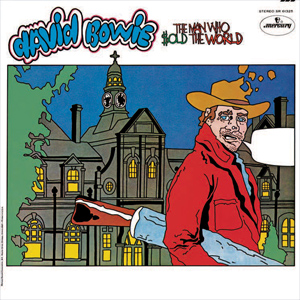
The Dutch (being different) released the album with yet another cover, this time a cartoon like image of Bowie as some kind of weird looking angel. The fact that it didn’t sell in this market either makes the album a much sort after Bowie collectable.
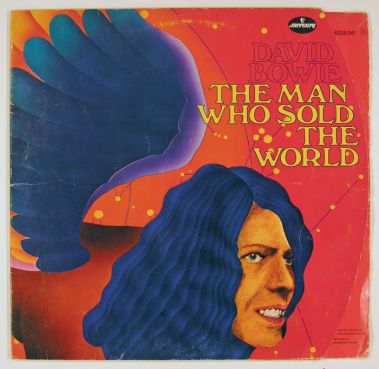
There have been a few notable re-releases over the years. The most significant was in 1972 when his new record company RCA after the commercial success that was the Ziggy Stardust album bought the rights off Mercury (as they did the second David Bowie album) and re-released it with a new Ziggy era black and white cover. With the market finally craving anything to do with Bowie, the album some two years after its initial release achieved moderate commercial success, reaching a respectable No. 24 in the UK and No. 105 in the US.
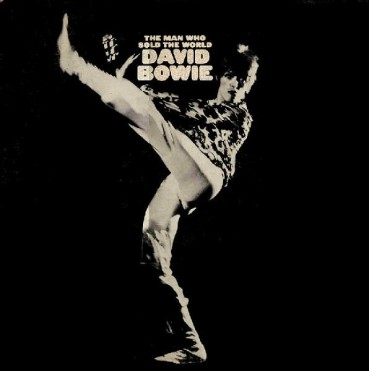
The less said about the dreadful (but collectable) RCA CD release the better, but in 1990 Rykodisc released it with original UK cover restored and included a number of bonus tracks including:
“Lightning Frightening” had been available on various bootlegs for years, but it was nice getting a clean sounding version of the song. That said however, it’s basically a forgettable, ploddy jam with Bowie and a few mates in tow. Recorded during the “Arnold Corns” sessions in 1971, a side-project that never went anywhere other than to rehearse some early versions of what would subsequently be Ziggy Stardust classics.
“Holy Holy” was the only single released by Bowie during this period, viewed as being more single worthy than anything found on the album. However, unlike what the sleeve notes mentioned on this re-release CD, the version here is actually not the original single but the vastly superior re-recorded version Bowie laid down as part of the Ziggy Stardust sessions. The original version (which you can find on the “Five Years” box set released in 2015 that covers Bowie’s 1969-1973 period) has a decidedly T-Rex vibe, more so with the Bolan-like “Black Country Rock” on the B-side. Basically Bowie trying to convert angelic person to be just a little more devilish (“I don’t want to be an angel, just a little bit evil, Feel the devil in me“) it’s a quaint enough track, but no surprise it tanked without a trace. The Ziggy Stardust version found here is vastly superior, with the Spiders From Mars providing much more energy and sense of fun to the whole thing.
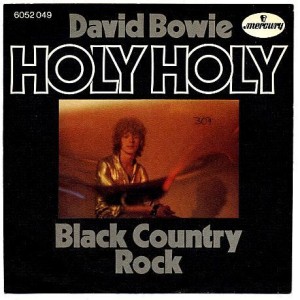
The album was notably re-mastered again in 1999 as part of the EMI re-release series and again in 2015 for its inclusion in the above mentioned “5 Years” box set.
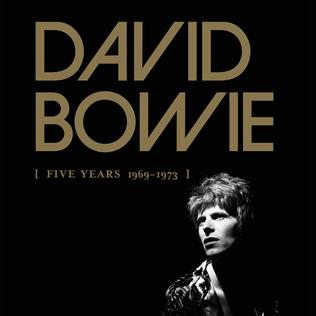
Finally, in 2016 as part of Record Store Day, 5000 copies of the Dutch Cover were produced as a limited picture-disc (yes, I’ve got my copy but will likely never get played).
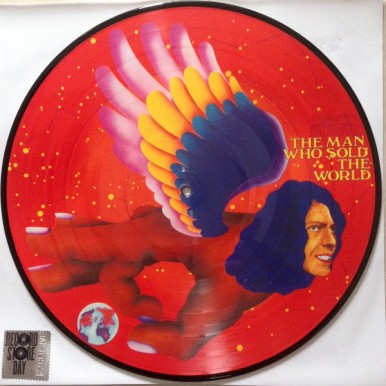
Another version of the album worth exploring is a live version recorded by “Holly Holly“, a “super” band including both Tony Visconti and Woody Woodmansey from the original sessions. A project put together in 2014 by the two originals to give the album a live experience for the first time, they are all rather good. Yes, the main vocalist Glenn Gregory (from Heaven 17) isn’t quite David Bowie (but let’s be honest, no one is), the whole experience is a lot of fun and worth checking out. They also perform a bunch of other Bowie classics from Bowie’s glam era that are also all rather excellent and worth a listen as well. Remarkably, “The Man Who Sold The World” is the only Bowie album on which Visconti and Woodmansey both feature.
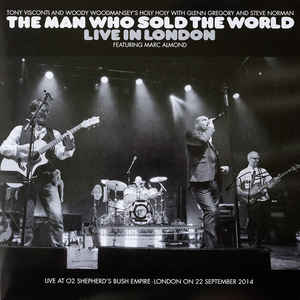
“The Man Who Who Sold The World” is a Bowie masterpiece, one which has never quite got the accolades it deserves. Full of wonderful, complex, cryptic musical experiences, it truly highlighted what lay ahead for Bowie. Although yet another huge commercial failure, Bowie was getting more than used to disappointment and quickly moved on. Tony Visconti, frustrated and more than a little annoyed by Bowie’s apparent disinterest during the recording sessions would leave the scene for a number of years, concentrating on his work with Marc Bolan’s T-Rex that had just started to really take-off (Visconti would finally get back with Bowie when mixing the “Diamond Dogs” album in 1974).
However, with this album the seeds of success had been planted with both Ronson and Woodmansey now on board. It would be another 18 months before Bowie would finally taste success on a permanent basis with the monster album that was Ziggy Stardust. But that’s a story for another day.
Best Tracks: “The Man Who Sold The World“, “All The Madmen“, “Saviour Machine“
